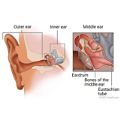Test Overview
A hearing (audiometric) test is part of a full hearing health evaluation that measures a person's ability to hear sound.
The sounds we hear start as vibrations in our environment that make sound waves, which vibrate at a certain speed (frequency) and have a certain height (amplitude). The vibration speed of a sound wave determines how high or low a sound is (pitch). The height of the sound wave determines how loud the sound is (volume).
Hearing happens when these sound waves travel through the ear and are turned into nerve impulses. These nerve impulses are sent to the brain, which "hears" them.
- Sound waves enter the ear through the ear canal (external ear). Then they strike the eardrum (tympanic membrane). The eardrum separates the ear canal and the middle ear.
- The eardrum vibrates, and the vibrations move through the bones of the middle ear. In response, the bones of the middle ear vibrate, which boosts the sound and sends it to the inner ear.
- The fluid-filled, curved space of the inner ear, sometimes called the labyrinth, contains the main sensory organ of hearing. This organ is called the cochlea. Sound vibrations cause the fluid in the inner ear to move, which bends tiny hair cells (cilia) in the cochlea. The movement of the hair cells creates nerve impulses. These nerve impulses then travel along the cochlear nerve to the brain and are read as sound.
Hearing tests help find what kind of hearing loss you have. The tests measure how well you can hear sounds that reach the inner ear through the ear canal. They also measure sounds that are spread through the skull.
Most hearing tests ask you to respond to a series of tones or words. But there are some hearing tests that do not require a response.
Why It Is Done
Hearing tests may be done:
- To check, or screen, babies and young children for hearing problems that might affect their ability to learn, speak, or understand language. The Canadian Paediatric Society recommends that all newborns be screened for hearing loss.footnote 1 Most provinces and territories in Canada offer newborn hearing tests for all babies born in hospitals. Also, many health groups and doctors' groups suggest routine screening. Talk to your doctor about whether your child has been or should be tested.
- To screen children and teens for hearing loss. Hearing should be checked by a doctor at each routine checkup. In children, normal hearing is important for proper language development. Some speech, behaviour, and learning problems in children can be related to problems with hearing. For this reason, many schools provide hearing tests when children first begin school.
- To test for possible hearing loss in anyone who has noticed an ongoing hearing problem in one or both ears or has had a hard time understanding words in conversation.
- To screen for hearing problems in older adults. Hearing loss in older adults is often mistaken for a reduced mental ability. (For example, a person may seem to not listen or respond to conversation.)
- To screen for hearing loss in people who are often exposed to loud noises or who take certain antibiotics, such as gentamicin.
- To find out the type and amount of hearing loss (conductive, sensorineural, or both). In conductive hearing loss, the movement of sound (conduction) is blocked or does not pass into the inner ear. In sensorineural hearing loss, sound reaches the inner ear, but a problem in the nerves of the ear or, in rare cases, the brain itself prevents proper hearing.
How To Prepare
- Tell your doctor if you take or have taken antibiotics that can damage hearing, such as gentamicin.
How It Is Done
Before the test
Before you start any hearing tests, your ear canals may be checked for earwax. Wax can affect how well you hear. Any hardened wax may be removed.
If you wear hearing aids, you may be asked to remove them for some of the tests.
Tuning fork tests
Your doctor strikes the tuning fork to make it vibrate and produce a tone. Sometimes the tuning fork will be placed on your head or behind your ear.
Pure tone audiometry
A machine called an audiometer plays a series of tones through headphones. The tones change in pitch and loudness. Your doctor will reduce the loudness of a tone until you can no longer hear it. Then the tone will get louder until you can hear it again. If you can hear the tone, you signal by raising your hand or pressing a button.
The headphones will then be removed. A special vibrating device will be placed on the bone behind your ear. Again, you will signal each time you hear a tone.
Speech reception and word recognition tests
In these tests, you hear a series of simple words spoken with different degrees of loudness. You are asked to repeat the words. Your doctor measures the level at which you can no longer hear the words well enough to repeat them.
Auditory brain stem response (ABR) testing
In this test, electrodes are placed on your scalp and on each earlobe. Clicking noises are then sent through earphones. The electrodes monitor your brain's response to the clicking noises and record the response on a graph.
How long the test takes
- The tests usually take about 1 hour.
How It Feels
This test usually doesn't cause any pain or discomfort.
Risks
There are no known risks from having this test.
Results
|
Normal |
|
|---|---|
|
Abnormal |
|
Sound is described in terms of frequency and intensity. Your hearing threshold is how loud the sound of a certain frequency must be for you to hear it.
- Frequency, or pitch (whether a sound is low or high), is measured in vibrations per second, or hertz (Hz). The human ear can normally hear frequencies from a very low rumble of 20 Hz to a high-pitched whine of 20,000 Hz.
- Intensity, or loudness, is measured in decibels (dB). The normal range (threshold or lower limit) of hearing is 0 dB to 25 dB. Normal results show that you hear within these ranges in both ears.
The following table relates how loud a sound must be for a person to hear it (hearing thresholds) to the degree of hearing loss for adults:
|
Hearing threshold in decibels (dB) |
Degree of hearing loss |
Ability to hear speech |
|---|---|---|
|
0–25 dB |
None to slight |
No significant trouble hearing. |
|
26–40 dB |
Mild |
Trouble with faint or distant speech. |
|
41–55 dB |
Moderate |
Trouble with conversational speech. |
|
56–70 dB |
Moderate to severe |
Speech must be loud; trouble with group conversation. |
|
71–90 dB |
Severe |
Trouble with loud speech. Understands only shouted or amplified speech. |
|
91+ dB |
Profound |
May not understand amplified speech. |
Related Information
References
Citations
- Patel H, et al. (2011). Universal newborn hearing screening. Paediatrics and Child Health, 16(5): 301–305. Also available online: http://www.cps.ca/English/statements/CP/cp11-02.htm.
Credits
Adaptation Date: 6/14/2023
Adapted By: HealthLink BC
Adaptation Reviewed By: HealthLink BC
Adaptation Date: 6/14/2023
Adapted By: HealthLink BC
Adaptation Reviewed By: HealthLink BC


